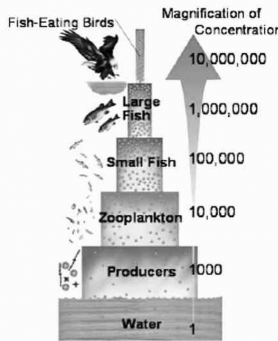2.5.1. Bioaccumulation
♤ It refers to how pollutants enter a food chain.
♤ In bioaccumulation there is an increase in concentration of a pollutant from the environment to the first organism in a food chain.
2.5.2. Biomagnification

Biomagnification
♤ Biomagnification refers to the tendency of pollutants to concentrate as they move from one trophic level to the next.
♤ Thus in biomagnification there is an increase in concentration of a pollutant from one link in a food chain to another.
In order for biomagnification to occur, the pollutant must be: long-lived, mobile, soluble in fats, biologically active.
If a pollutant is short-lived, it will be broken down before it can become dangerous. If it is not mobile, it will stay in one place and is unlikely to be taken up by organisms. If the pollutant is soluble in water, it will be excreted by the organism. Pollutants that dissolve in fats, however, may be retained for a long time.
It is traditional to measure the amount of pollutants in fatty tissues of organisms such as fish. In mammals, we often test the milk produced by females, since the milk has a lot of fat in it are often more susceptible to damage
from toxins (poisons). If a pollutant is not active biologically, it may biomagnify, but we really don’t worry about it much, since it probably won’t cause any problems Examples: DDT.
